2007 年山东青岛科技大学基础英语考研真题
I. Each sentence below has one or two blanks. Complete each of the following
sentences by filling the blanks with one from the 4 choices provided to best fit
the meaning of the sentence. (20×2 points)
1. Roger ’ s understanding of the pointillist technique is profound, albeit
thoroughly_____; there are few who can _____ his talent, recognized often and
justly, for understatement and economy in the use of color.
(A) brilliant … imitate
(B) specialized … match
(C) needless … disregard
(D) ill-founded … approximate
2. Several surgeons cautioned against _____ the new procedure, _____ that patients
had been kept in the dark too long about its possible catastrophic consequences.
(A) revising … advocating
(B) publicizing … adding
(C) adopting … complaining
(D) administering … forgetting
3. The primary impulse of each human being is to _____ himself, but the secondary
impulse is to venture out of the self, to correct its provincialism and heal its
loneliness.
(A) actualize
(B) reject
(C) declare
(D) withdraw
4. It is difficult to conceive how, even for those people well disposed to rule
themselves, the attempt to achieve happiness should be rendered so _____ by one
single curse, that of a bad form of government.
(A) ineffectual
(B) corrupt
(C) disorganized
(D) ill-tempered
5. Henry James was to some degree interested in exploring his characters ’
psychologies, though he was _____ this enterprise less by _____ than by sympathy.
(A) seduced into … affection
(B) impelled to … curiosity
(C) discouraged from … apathy
(D) intrigued by … self-pity
6. As has always been the case when tragedy has struck our community, the people
of our town feel the obligation, and rightly so, to _____ in support of the victim
and his family.
(A) provoke
(B) discontent
�
(C) rally
(D) apologize
7. The great leaders of the second world war alliance, Franklin Roosevelt and Winston
Churchill, understood the opposing forces of destruction and _____; their war aims
were not only to defeat fascism, but to create a world of shared ____ .
(A) grief … solutions
(B) hope … domination
(C) disaster … antipathy
(D) construction … prosperity
8. One encouraging sign in the problem of chaos among the soldiers’ ranks was their
vow, for what it was worth, to act in a more _____ way.
(A) concerted
(B) ingenious
(C) defiant
(D) diligent
9. A gulf remains between negotiators from the rich world, who are so skeptical they
hope to see the treaty’s ambitious provisions _____, and those from poor countries,
who want them _____.
(A) absorbed… ignored
(B) diluted … strengthened
(C) reinforced … removed
(D) relaxed … loosened
10. Few mathematicians are _____ their futures on finding any such proof; instead,
their efforts are focused on finding good, but not _____, solutions for most cases,
a field of study aptly known as approximation theory.
(A) destroying … exact
(B) developing … convenient
(C) betting … perfect
(D) establishing … vague
11. Because many of the blacklists in the communications and entertainment
industries were secret, the number of playwrights, script writers, novelists, and
journalists who were _____ to stop writing permanently is _____ .
(A) happy … astounding
(B) forced … unknown
(C) unafraid … impressive
(D) inclined … unsurprising
12. After the investigations and _____ that are both necessary and inevitable after
a calamity such as the recently ended crisis, it may turn out that authorities
could have handled the problem in a less _____ way.
(A) observation … convenient
(B) analyses … fashionable
(C) second-guessing … costly
(D) footwork … organized
13. Handedness can be influenced and changed by social and cultural mechanisms, as
�
can be evidenced by the fact that teachers have been known to force children to
switch from using their left hand to using their right hand for writing and that
some more ____ societies show less left-handedness in their populations than other
more _____ societies.
(A) restrictive … permissive
(B) liberal … suppressive
(C) dominating … plural
(D) intriguing … monotonous
14. His _____ of the assigned pages was itself a much too lengthy summary; by all
accounts, if he wishes to succeed by the standards of succinctness and concision,
he must learn to restrain his _____.
(A) development … technique
(B) synthesis … interest
(C) analysis … construction
(D) synopsis … verbosity
15. Although most people who acquire West Nile have no _____ and those who do normally
suffer little more than flu-like illness, it is believed they still can carry _____
amounts of the virus in their blood for several days.
(A) recourse … hope
(B) symptoms … minute
(C) cure … significant
(D) fever …active
16. The purpose of interior design is to create a physical environment that is _____
yet connected to the outside world, an environment that is ideal for the pursuit
of relaxation in a zone of paritial_____.
(A) transcendent of … tastefulness
(B) linked to … autonomhy
(C) peripheral to … tranquility
(D) separate from … isolation
17. Future generations of physicists may look at the _____ of their former ideas
and see in it, not the relics of some extinct creature, but a crude, early, yet
wholly _____ version of their more modern theories.
(A) mockery … distinct
(B) laughable … congruous
(C) skeleton … recognizable
(D) treatment … suspect
18. With legal migration, governments need to persuade voters that they are accepting
for the country, rather than those who will _____
immigrants who will be _____
drain resources.
(A) beneficial … merely
(B) exotic … constantly
(C) amusing … ungraciously
(D) helpful … seldom
19. Sadly, Americans of every ethnicity still demand ideological _____ among their
�
own kind---although we’re all multi-culturalists now, we’re much more _____
discussing diversity across the rainbow than within each other.
(A) subservience … catholic
(B) resonance … sensitive
(C) conformity … comfortable
(D) reflection … generous
20. The reality of governance is rarely _____; institutions do not operate according
to mechanical laws, they evolve organically.
(A) inconsistent
(B) noble
(C) documented
(D) static
II. Read the following 2 passages and choose the best answer to each question about
them. (10×4 points)
Passage One
Most words are “lexical words”, i.e. nouns signifying ‘things’, the majority
of which are abstract concepts rather than physical objects in the world; only
“proper nouns” have specific and unique referents in the everyday world. The
communicative function of a fully-functioning language requires the scope of
reference beyond the particularity of the individual instance. While each leaf,
cloud or smile is different from all others, effective communication requires
general categories or “universals”. Anyone who has attempted to communicate with
people who do not share their language will be familiar with the limitations of simply
pointing to things, given that the vast majority of lexical words in a language exist
on a high level of abstraction and refer to classes of things such as “buildings”
or to concepts like “construction”.
We lose any one-to-one correspondence of word and thing the moment we group
instances into classes. Other than lexical words, language consists of “function
words” or grammatical words, such as “only” and “under” which do not refer to
objects in the world at all, and many more kinds of signs other than simple nouns.
The notion of words as labels for concepts assumes that ideas exist independently
of words and that ideas are established in advance before the introduction of
linguistic structure. Clearly, language is not limited to naming things existing
in the physical world, but includes non-existent objects and ideas well.
The nomenclaturist stance, in viewing words as labels for pre-existing ideas
and objects, attempts unsuccessfully to reduce language to the purely referential
function of naming things. Things do not exist independently of the sign systems
which we use; “reality” is created by the media which seem simply to represent
it. Language does not simply name pre-existing categories; categories do not exist
in “the world”. e.g. “where are boundaries of a cloud; when does a smile begin”.
Such an emphasis on reality as invariably perceptually seamless may be an
exaggeration; our referential categories do seem to bear some relationship to
�
certain features which seem to be inherently salient. Within a language, many words
may refer to “the same thing” but reflect different evaluations of it. For example,
“one person’s ‘hovel’ is another person’s ‘home’”.
Meanwhile, the signified of a word is subject to historical change. In this sense,
“reality” or “the world” is created by the language we use: this argument insists
on the primacy of the signifier. Even if we do not adopt the radical stance that
“the real world” is a product of our sign systems, we must still acknowledge the
lack of signifiers for many things in the empirical world and that there is no
parallel correlation between most words and objects in the known world at all. Thus,
all words are “abstractions”, and there is no direct correspondence between words
and “things” in the world.
1. The author of the passage is primarily concerned with
(A) refuting a belief held by one school of linguistics
(B) reviewing an interesting feature of language
(C) illustrating the confusion that can result from the improper use of languae
(D) suggesting a way in which languages can be made more nearly perfect
2. The author offers all of the following ideas as proof that there is no direct
correspondence between words and things EXCEPT
(A) Language has other functions than that of reference.
(B) Many words refer to objects that do not exist in the world.
(C) Function words do not refer to objects.
(D) Proper nouns usually refer to unique entities.
3. According to the passage, which of the following assumptions would the
“nomenclaturist” most likely agree with?
(A) The seamlessness of reality complicates the notion of linguistic categories,
such that those categories must be questioned.
(B) The experience of reality largely varies form that of the experience of
language, weakening the reliability of both experiences.
(C) Ideas invariably precede, in their existence and meaning, the language that
subsequently articulates them.
(D) The meaning of a word is not fixed historically, and may evolve over time due
to a variety of factors.
4. It can be inferred from the passage that the author is LEAST likely to agree with
which of the following?
(A) Words can be categorized into different grammatical functions.
(B) Some relationship between signifier and signified can be articulated.
(C) Every signifier points to a single pre-existing signified.
(D) Words may name imaginary, non-physical things.
5. It can be inferred from the passage that the term “reductionist” would most
likely apply to which of the following views concerning language?
(A) A number of words exist with identical meanings.
(B) Several words with different connotations may refer to the same object.
(C) A word used two centuries ago might refer to the same object today.
(D) Reality is constructed, not discovered, by the medium of language.
�
Passage Two
The distinction between making art and thinking and writing about it should
imply neither a mutual exclusiveness nor a hierarchic differentiation of these
processes. Leonardo demonstrated that producing art and theorizing about it need
not be antithetically opposed activities and that meaningful contributions can be
achieved successfully in more than one field. Inexplicably, few theorists have built
as memorable architectural structures as his and even fewer artists have been
entrusted with the directorship of an influential art institution. Unfortunately,
as theory and practice became more specialized in the modern era and their
operational framework clearly defined both in the cultural milieu and the
educational process, their independent paths and boundaries have curtailed
possibilities of interaction. The creations of categories and divisions have further
emphasized highly individualized idiosyncrasies and, by exposing differences,
diminished the value of a unifying artistic vocabulary. The transformative cultural
process of the last decades has critically examined the artificial separations
between theoretical and studio practices and disclosed viable connections between
making, writing, thinking, looking and talking about art. The recent dialogue
between the various components of the artistic discourse has recognized the common
denominators shared by theoretical analyses and artistic production, one of which
is clearly exposed by the argument that the central objective of the theorist and
artist is to unmask and understand artistic meanings in painting or text.
The notion that “true” art is the product of individuals who are incapable of
in-depth
understanding, in stark contrast to erudite, restrained and controlled scholars,
is an outdated model. The assumption that artists make art but cannot or do not have
to talk or write about it and that theorists rarely know anything about the creative
process, has been consistently refuted by the many texts written from Leonardo da
Vinci to Mary Kelly. Even van Gogh, a martyr of the stereotypical “misunderstood
genius,” whose artistic career has been distorted by scores of films and books,
wrote with lucidity and insight about art and his work. Apparently, the “mystery”
of the creative process, jealously protected by artists but also selectively
cultivated by some art historians has been both a fascination and frustration for
those extrinsic to the process and artists have exposed the intimacy of creativity
while acknowledging the role of cognition in creativity.
Even the ironic and subversive demise of authorship of the post-modern and
electronic age acknowledges, at least indirectly, the value of the artist ’ s
individual participation. However, many contemporary artists have abandoned the
hierarchic segregation of the inner realm of the creator and, by combining
theoretical and studio practices, brought a reconciliatory tone to the processes
of making art and analyzing it. Their works, which are often simultaneously artistic
productions and critique of the artistic discourse, making use of visual and textual
forms to expose the connection between looking and thinking as the essential
�
attribute to both creating and understanding art.
6. According to the passage, the specialization of art and theory has tended to
(A) reduce the level of control artists have over artistic institutions
(B) increase the usefulness of creating a unifying artistic vocabulary
(C) permit a greater level of development of knowledge concerning both
(D) curtail interactions and establish false boundaries between the two fields
7. It can be inferred from the passage that prior to the modern era artistic practice
was regarded as
(A) a hermetic field without potential for collaboration, given that it was almost
exclusively populated by “misunderstood genius”
(B) a field less isolated from the practice of critical analysis than the artistic
process of the present era
(C) more meaningful and useful as a self-critical force than the aesthetic
judgments of non-artists, especially art historians
(D) primarily concerned with the masking and concealment of artistic meanings from
the general public
8. The passage suggests that the mystification of the artistic process by certain
art historians and artists can be traced to
(A) the necessity of protecting artistic meaning from a general public who would
most likely misunderstand and object to it
(B) an unconscious tendency of non-artists to lionize those artists whom the public
admires but fails to understand
(C) a desire to protect and maintain the isolation between those who make art and
those who analyze it, so as to reinforce the creative/critical distinction
(D) a movement to expunge the challenging texts of dual artist/critics like
Leonardo da Vinci and Mary Kelly from the critical canon
9. The passage suggests that the post-modernist relegation of an artwork’s author
to a minor and irrelevant post
(A) has resulted in a greater embrace of art forms that are sometimes wholly
electronic
(B) has failed to entirely counter the notion that art-making originates at some
point with an individual
(C) has enabled artists to demonstrate the visual and textual connections between
art and art criticism
(D) has tended to subtly reinforce the ways in which artists are perceived as
martyrs
10. The author’s primary purpose in mentioning van Gogh is most likely to
(A) cite the case of an artist whose intention was to increase the mystification
of the artistic process
(B) discuss an artist whose life has been consciously distorted by biographers
and filmmakers
(C) give an example of an artist depicted as incapable of comprehending his own
art work but able to do so in fact
(D) provide an instance of an artist whose work can scarcely be understood without
�
the assistance of art critics
III. Read the following passage and translate it into good Chinese. (30 points)
One uniform and harmonious system appealed to the imagination as a triumph of
human progress, offering prospects of peace and ease, contentment and philanthropy,
such as the world had not seen; but it invited dangers, formidable because unusual
or altogether unknown. The corruption of such a system might prove to be
proportionate with its dimensions, and uniformity might lead to evils as serious
as were commonly ascribed to diversity.
The laws of human progress were matter not for dogmatic faith, but for study;
and although society instinctively regarded small States, with their clashing
interests and incessant wars, as the chief obstacle to improvement, such progress
as the world knew had been coupled with those drawbacks. The few examples offered
by history of great political societies, relieved from external competition or
rivalry, were not commonly thought encouraging. War had been the severest test of
political and social character, baling bare whatever was feeble, and calling out
whatever was strong; and the effect of removing such a test was an untried problem.
In 1815 for the first time Americans ceased to doubt the path they were to follow.
Not only was the unity of their nation established, but its probable divergence from
older societies was also well defined. Already in 1817 the difference between Europe
and America was decided.
IV. Read the following passage and finish the writing task following it. (40 points)
Mary continued to look for a job, without success. Then she got a letter from
a former colleague named Louise who was now on the faculty of a famous college in
upstate New York. She said that one of her colleagues would be retiring at the end
of the year and asked whether Mary would be interested in the position.
The letter surprised Mary, because enthusiasm for other people’s cause did not
come to Louise easily. Mary expected nothing, but sent a resume and copies of her
two books. Shortly after that Louise called to say that the search committee, of
which she was chairwoman, had decided to grant Mary an interview in early November.
The college looked the way colleges are supposed to look. Roger, a student who
was assigned to show Mary around before the interview, explained that it was an exact
copy of a college in England, right down to the gargoyles and stained-glass windows.
Above the door of the Founder’s Building was a Latin motto which, roughly translated,
meant “God helps those who help themselves.” As Roger recalled the names of
illustrious graduates Mary was struck by the extent to which they had taken this
precept to heart. They had helped themselves to railroads, armies, states, to empires
of finance with outposts all over the world.
Roger took Mary to the chapel and showed her a plaque bearing the names of alumni
who had been killed in various wars. There were not many names. Here too, apparently,
the graduates had helped themselves.
“People think the college is really old-fashioned,” he said, “but it isn’
t. They let girls come here now, and some of the teachers are women. In fact, there’
s a statute that says they have to interview at least one woman for each opening.”
Mary arrived at the committee room exactly on time for her interview, but the
�
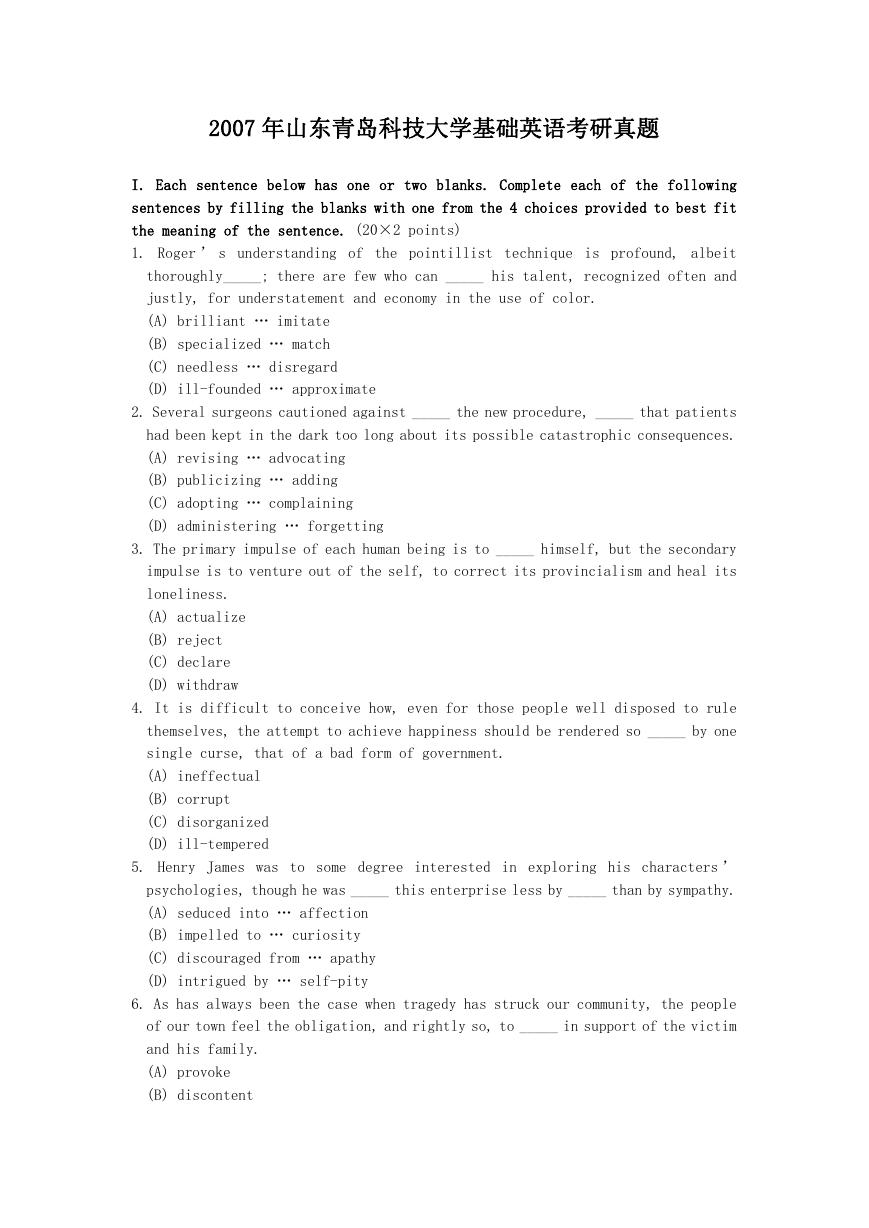
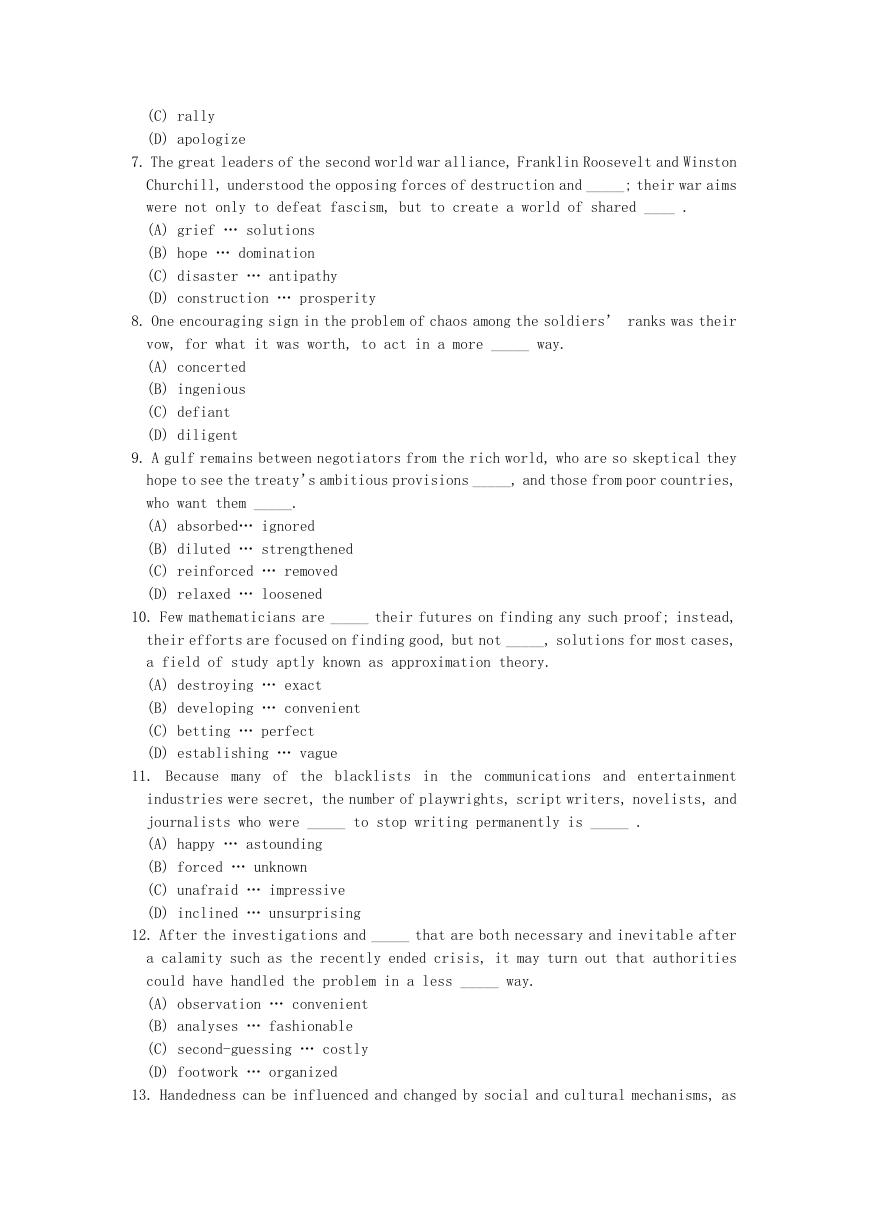
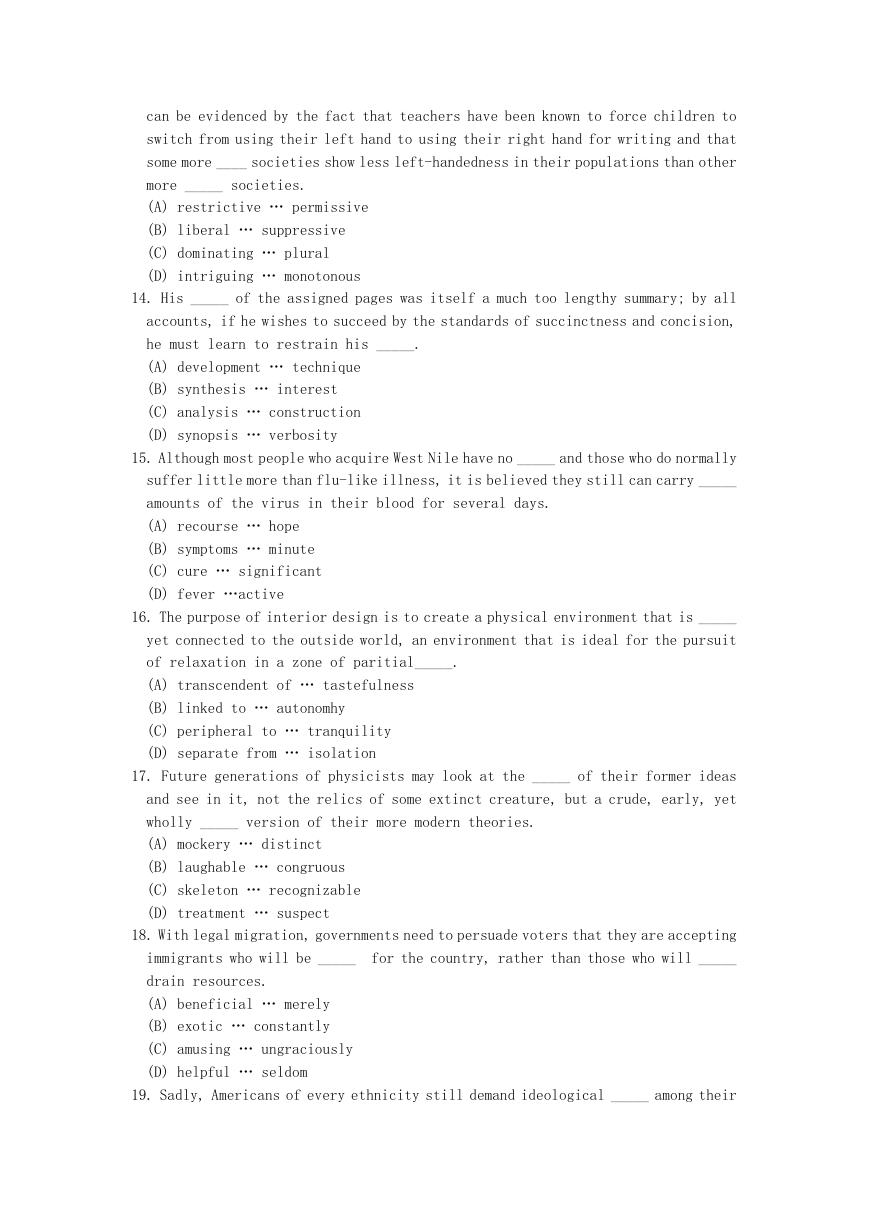
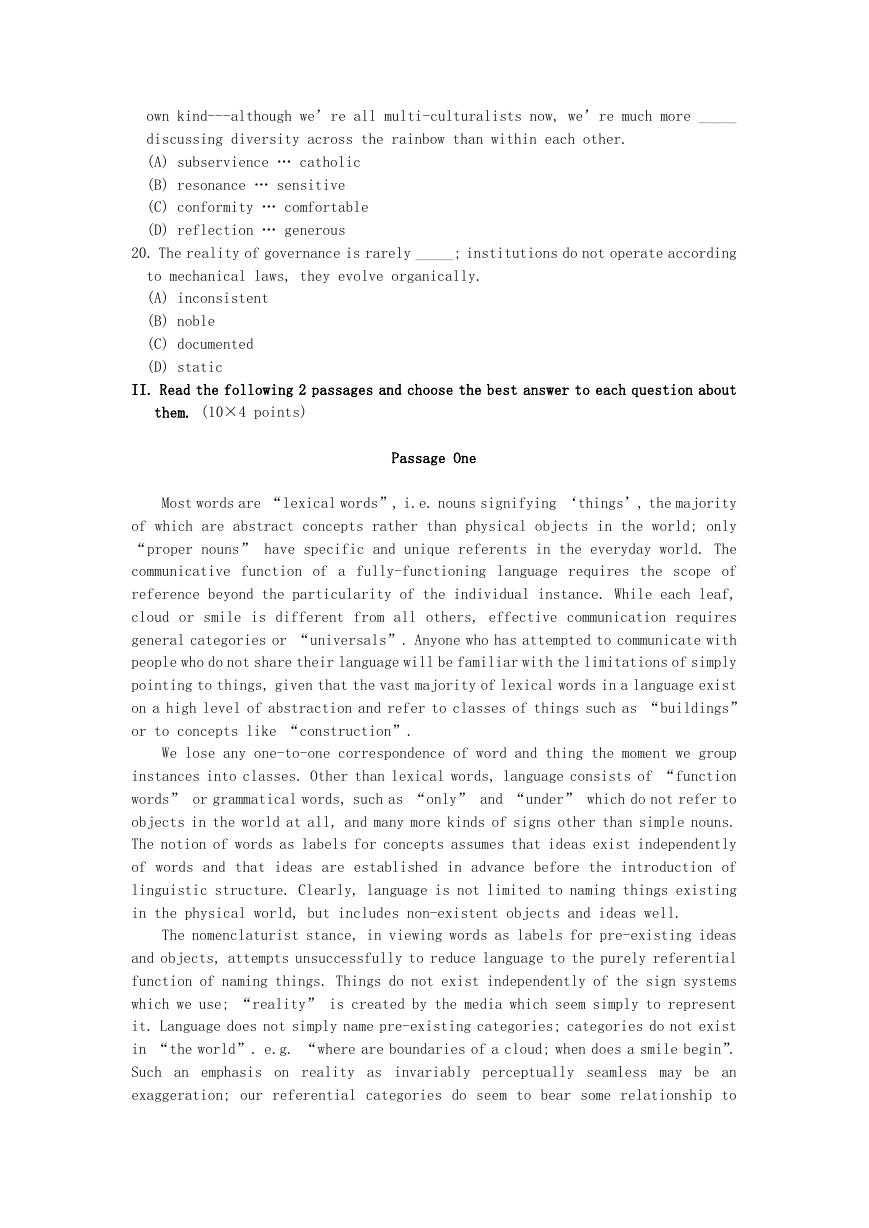

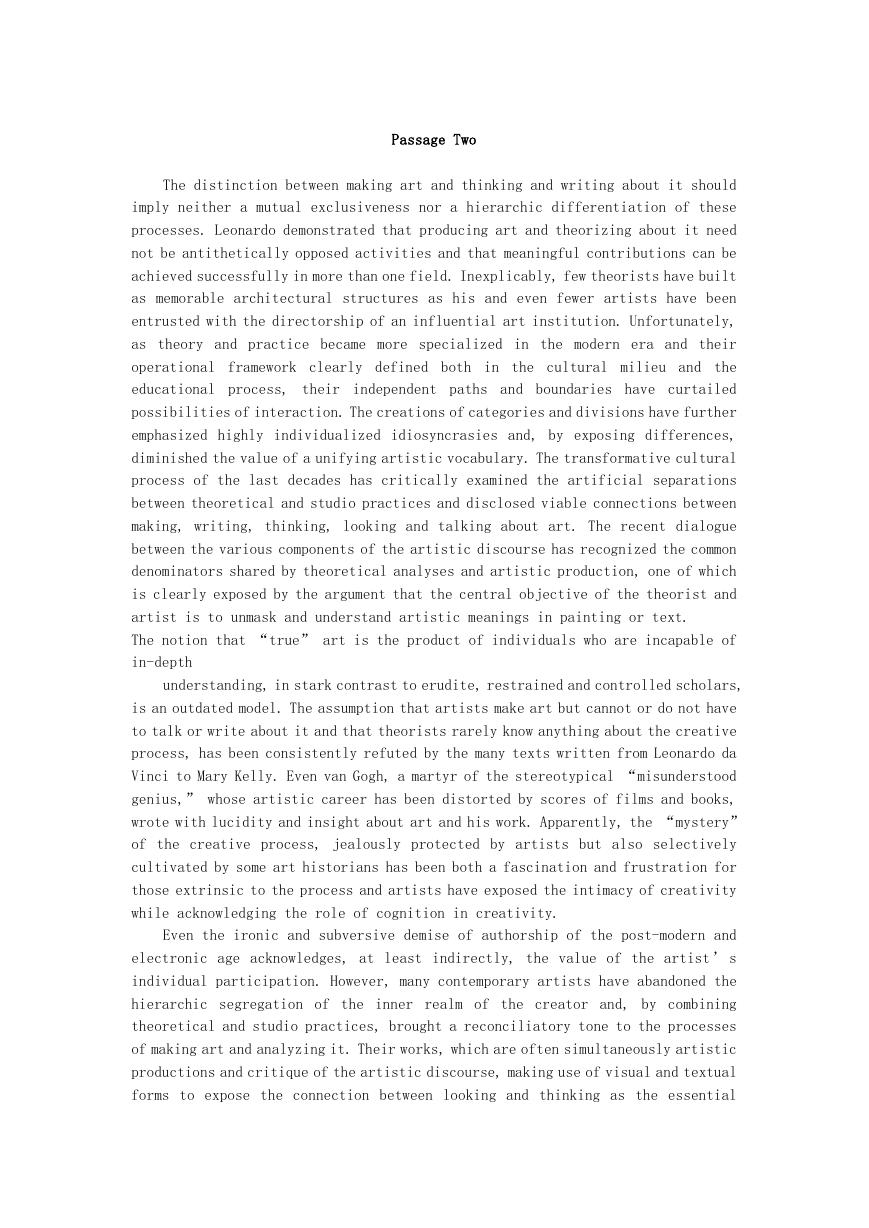
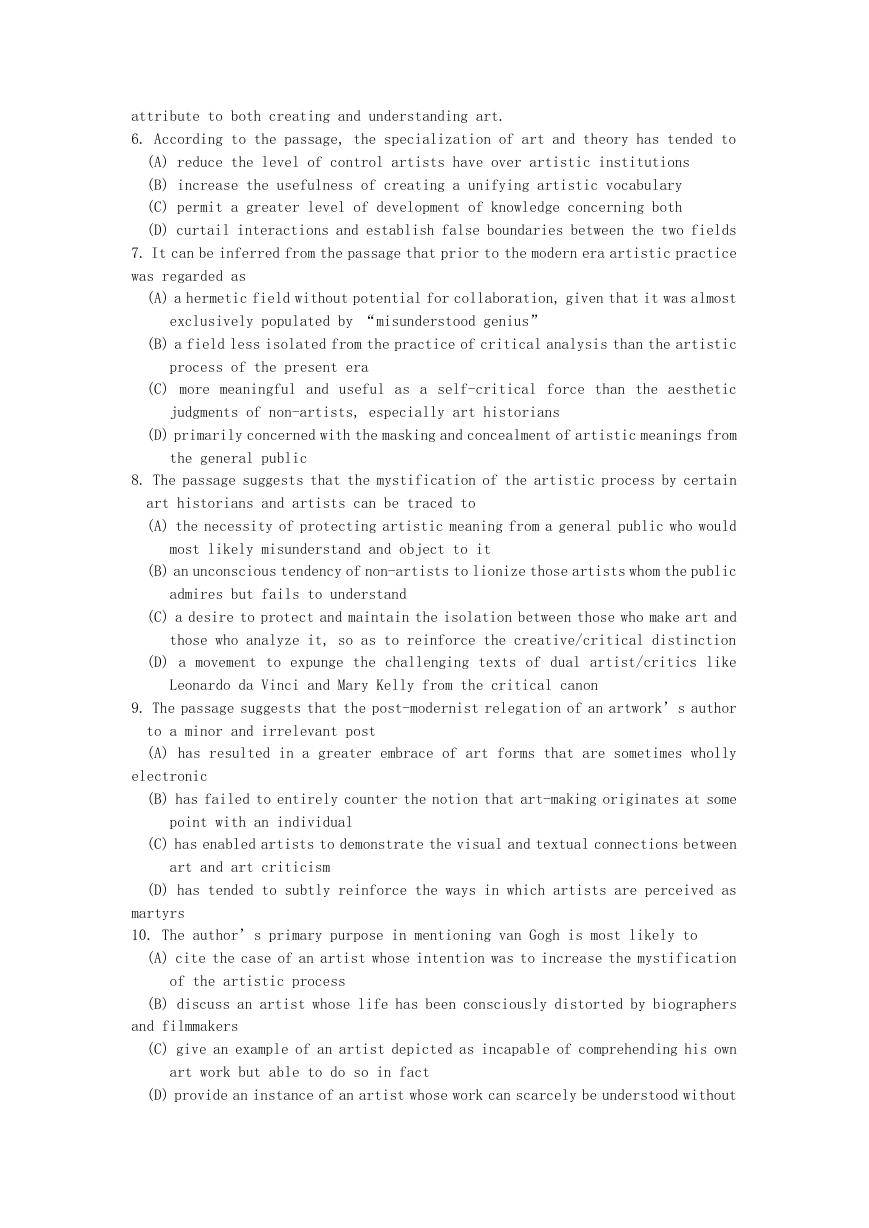
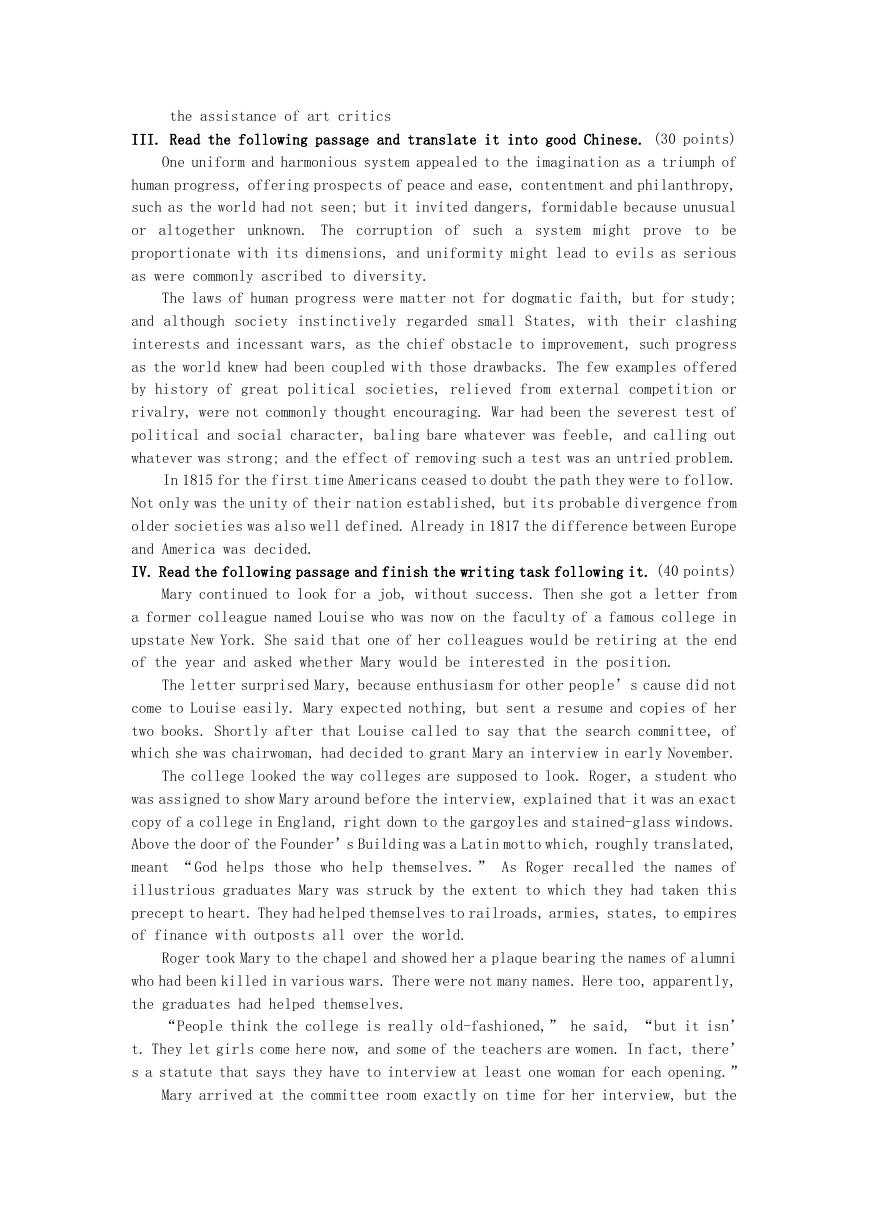








 2023年江西萍乡中考道德与法治真题及答案.doc
2023年江西萍乡中考道德与法治真题及答案.doc 2012年重庆南川中考生物真题及答案.doc
2012年重庆南川中考生物真题及答案.doc 2013年江西师范大学地理学综合及文艺理论基础考研真题.doc
2013年江西师范大学地理学综合及文艺理论基础考研真题.doc 2020年四川甘孜小升初语文真题及答案I卷.doc
2020年四川甘孜小升初语文真题及答案I卷.doc 2020年注册岩土工程师专业基础考试真题及答案.doc
2020年注册岩土工程师专业基础考试真题及答案.doc 2023-2024学年福建省厦门市九年级上学期数学月考试题及答案.doc
2023-2024学年福建省厦门市九年级上学期数学月考试题及答案.doc 2021-2022学年辽宁省沈阳市大东区九年级上学期语文期末试题及答案.doc
2021-2022学年辽宁省沈阳市大东区九年级上学期语文期末试题及答案.doc 2022-2023学年北京东城区初三第一学期物理期末试卷及答案.doc
2022-2023学年北京东城区初三第一学期物理期末试卷及答案.doc 2018上半年江西教师资格初中地理学科知识与教学能力真题及答案.doc
2018上半年江西教师资格初中地理学科知识与教学能力真题及答案.doc 2012年河北国家公务员申论考试真题及答案-省级.doc
2012年河北国家公务员申论考试真题及答案-省级.doc 2020-2021学年江苏省扬州市江都区邵樊片九年级上学期数学第一次质量检测试题及答案.doc
2020-2021学年江苏省扬州市江都区邵樊片九年级上学期数学第一次质量检测试题及答案.doc 2022下半年黑龙江教师资格证中学综合素质真题及答案.doc
2022下半年黑龙江教师资格证中学综合素质真题及答案.doc